Cisco CCNA Configuring a Static Frame Relay Map
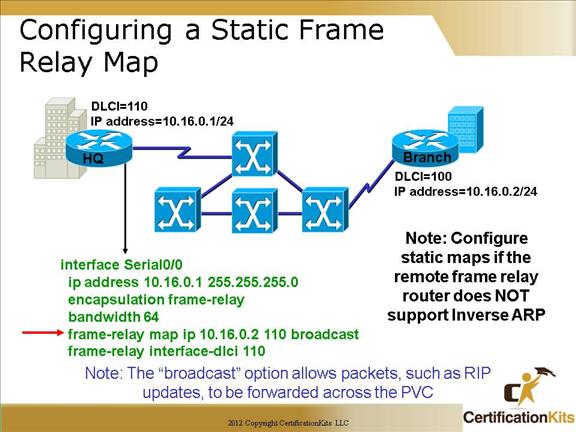
We can use the frame-relay map command to configure multiple DLCIs to be multiplexed over one physical link. Instead of using Inverse ARP, the Frame Relay map tells the Cisco IOS software how to get from a specific protocol and address pair to the correct DLCI.
The simplest way to generate a static map is to let the router learn the information dynamically first. Some users let the router learn the information dynamically, then enable static maps for easier network administration.
These configuration steps are the same, regardless of the network-layer protocols operating across the network.
Although static maps are not needed when Inverse ARP is enabled, it is a good idea to configure them for each connection for easier network administration.
Most modern frame relay networks utilize point-to-point or point-to-multipoint interfaces. This provides a great deal more control, and flexibility on behalf of the network administrators.
Cisco CCNA Configuring Address Mapping
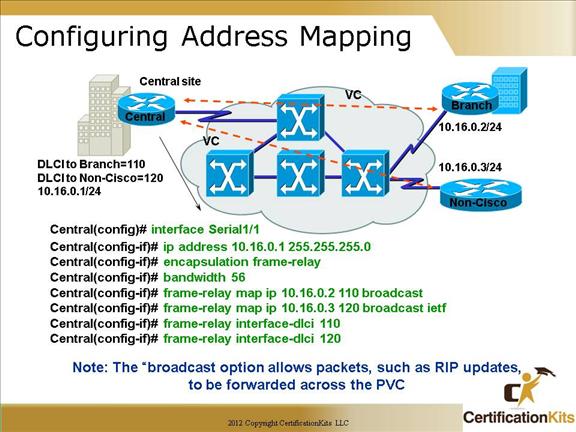
This figure discusses the static map command option:
You can use the frame-relay map command to configure multiple DLCIs to be multiplexed over one physical link. Instead of using Inverse ARP, the Frame Relay map tells the Cisco IOS software how to get from a specific protocol and address pair to the correct DLCI.
This command is similar to building a static route.
The simplest way to generate a static map is to let the router learn the information dynamically first. Some users let the router learn the information dynamically, then enable static maps for easier network administration.
These configuration steps are the same, regardless of the network-layer protocols operating across the network.
Although static maps are not needed when Inverse ARP is enabled, it is a good idea to configure them for each connection for easier network administration.
Cisco CCNA Frame Relay Topology
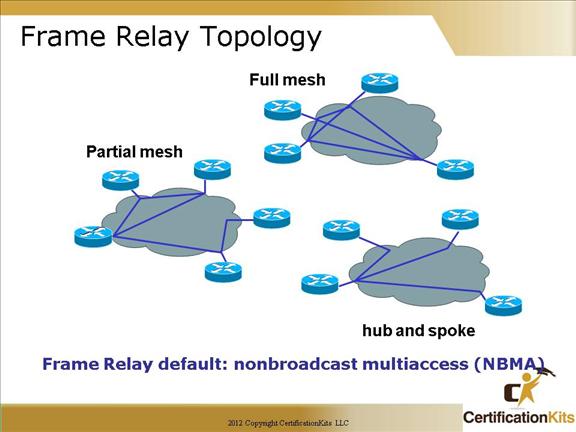
By default interfaces that support Frame Relay are multipoint connection types. This type of connection is not a problem when only one PVC is supported by a single interface; however it is a problem when multiple PVCs are supported by a single interface. In this situation, broadcast routing updates received by the central router cannot be broadcast to the other remote sites.
Broadcast routing updates are issued by distance vector protocols. Link-state and hybrid protocols use multicast and unicast addresses.
One concern about a Frame Relay network is how to handle broadcast traffic. Because Frame Relay is not a broadcast network by design, the distribution of broadcast traffic can only be accomplished by sending the same message to each virtual connection. This method requires considerable resource allocation within the router.
Cisco CCNA Routing Update problems
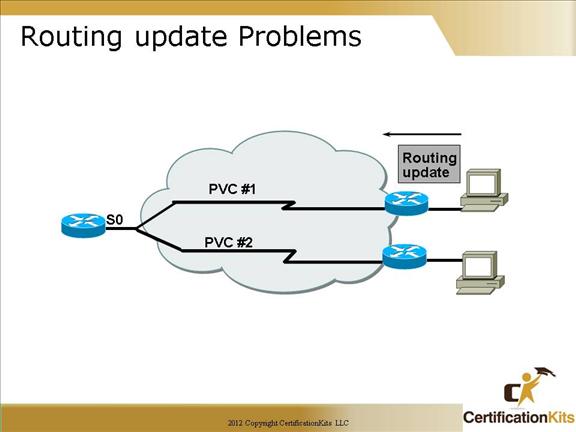
This figure continues the discussion the need for subinterfaces.
Partial mesh Frame Relay networks must deal with the case of split horizon not allowing routing updates to be retransmitted on the same interface from which they were received. Split horizon cannot be disabled for certain protocols such as AppleTalk.
Split horizon issues are overcome through the use of logical subinterfaces assigned to the physical interface connecting to the Frame Relay network.
A physical interface can be divided into multiple, logical interfaces. Each logical interface is individually configured and is named after the physical interface. A decimal number is included to distinguish it.
The logical port names contain a decimal point and another number, indicating that these are subinterfaces of interface serial 0 (S0).
Subinterfaces are configured by the same configuration commands used on physical interfaces.
A broadcast environment can be Frame Relay-created by transmitting the data on each individual circuit. This simulated broadcast requires significant buffering and CPU resources in the transmitting router, and can result in lost user data because of contention for the circuits.
Cisco CCNA Resolving Split-Horizon Issues
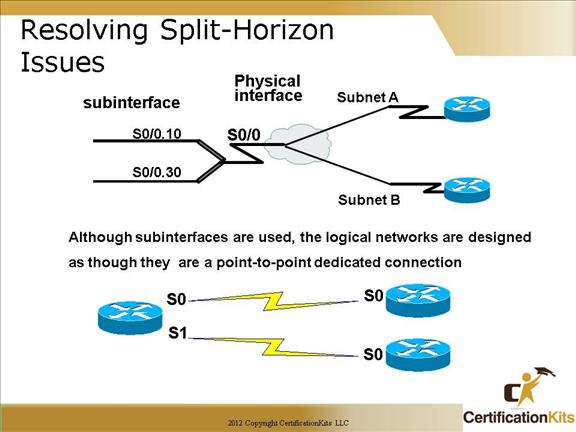
This figure defines subinterfaces and how they can resolve NBMA issues.
You can have connectivity problems in a Frame Relay network if the following conditions exist:
You are using an NBMA model.
Your configuration is in a partial mesh.
You are using a distance vector routing protocol.
Split horizon is enabled on the routing protocol.
If the routing protocol is configured with split horizon, routing updates from one router connected on the multipoint subinterface are not propagated to other routers connected on this multipoint subinterface. For example, if router C sends a routing update, this split horizon will keep this update from being sent back out the subinterface to router D.
To resolve this problem you can do the following:
Use Frame Relay subinterfaces to overcome the split horizon problem.
Use a routing protocol that supports disabling split horizon.
Use this configuration if you want to save IP address space.
You can also use this type of configuration with several fully meshed groups. Routing updates will be exchanged between the fully meshed routers.
Cisco CCNA Configuring Subinterfaces
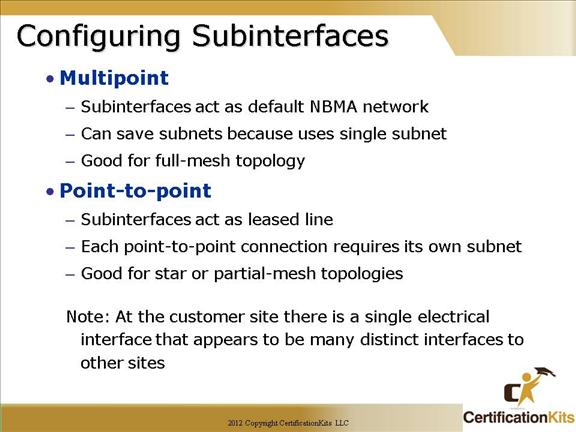
You can have multiple virtual circuits on a single serial interface and yet treat each as a separate interface. This is accomplished by creating subinterfaces. Think of a subinterface as a logical interface defined by the IOS software. Several subinterfaces will share a single hardware interface, yet for configuration purposes they operate as if they were separate physical interfaces.
The encapsulation frame-relay command is assigned to the physical interface. All other configuration items, such as the network-layer address and DLCIs, are assigned to the subinterface.
Multipoint may not save you addresses if you are using variable-length subnet masks (VLSMs). Further, it may not work properly given the broadcast traffic and split horizon considerations. The point-to-point subinterface option was created to avoid these issues.
Subinterfaces are also used with Asynchronous Transfer Mode (ATM) networks and Internetwork Packet Exchange (IPX®) LAN environments where multiple encapsulations exist on the same medium.
Cisco CCNA Configuring Subinterfaces Example
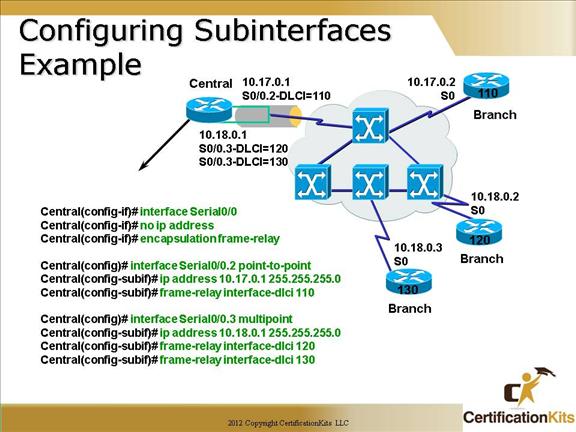
This figure continues the discussion of configuring subinterfaces.
The Frame Relay service provider will assign the DLCI numbers. These numbers range from 16 to 992. This range will vary depending on the LMI used.
Using the frame-relay interface-dlci command with subinterfaces provides greater flexibility when configuring Frame Relay networks. On multipoint subinterfaces, the frame-relay interface-dlci command enables Inverse ARP on the subinterface. When this command is used with point-to-point subinterfaces, all traffic for the subinterface’s subnetwork is sent out this subinterface.
The ability to change a subinterface from point-to-point to multipoint or vice versa, is limited by the software architecture. The router must be rebooted for this type of change to take effect. As an alternative exists to rebooting the router and creating a network outage, you can create another subinterface in the software and migrate the configuration parameters to the new subinterface using the proper point-to-point or multipoint setting, as required.
Another common migration strategy is to have new services provisioned in parallel and then simply scheduling the migration using the new DLCI numbers. New IP addressing can be added to bring up and test the new interface prior to putting traffic on it, and will facilitate a smooth transition to the new services.
Another best practice is to match the DLCI # with the sub-interface number. This aids in troubleshooting because it is less numbers needed to memorize to support the connectivity.
Cisco CCNA Point-t-Point Subinterfaces
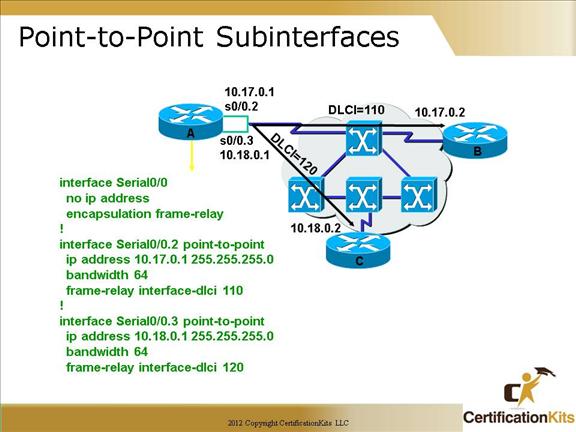
This figure continues the discussion of configuring subinterface
The Frame Relay service provider will assign the DLCI numbers. These numbers range from 16 to 992. This range will vary depending on the LMI used.
Use the frame-relay interface-dlci command on subinterfaces only. Use of the command on an interface, rather than a subinterface, will prevent the device from forwarding packets intended for the DLCI. It is also required for multipoint subinterfaces for which dynamic address resolution is enabled. It is not used for multipoint subinterfaces configured with the frame-relay map command for static address mapping.
Using the frame-relay interface-dlci command with subinterfaces provides greater flexibility when configuring Frame Relay networks.
On multipoint subinterfaces, the frame-relay interface-dlci command enables Inverse ARP on the subinterface. When this command is used with point-to-point subinterfaces, all traffic for the subinterface’s subnetwork are sent out this subinterface.
The ability to change a subinterface from point-to-point to multipoint, or vice versa, is limited by the software architecture. The router must be rebooted for a change of this type to take effect. An alternative exists to rebooting the router and creating a network outage. Create another subinterface in the software and migrate the configuration parameters to the new subinterface using the proper point-to-point or multipoint setting, as required.
Cisco CCNA Subinterfaces
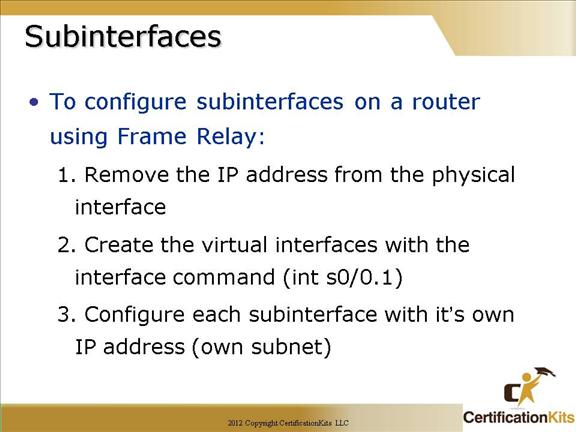
You must now specify the point-to-point or point-to-multipoint. Older IOS defaulted to multi-point, but later revisions force you to specify the type.
